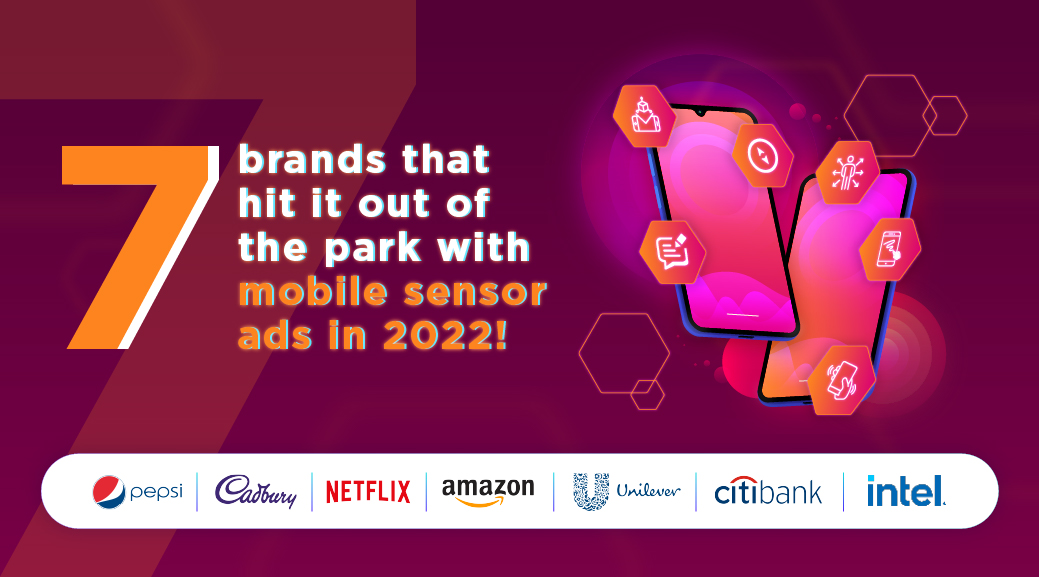
7 Brands that hit it out of the park with mobile sensor ads in 2022
Every time you pick up your phone, you interact with a mobile sensor. You switch it on with a fingerprint lock, swipe and scroll to see content and zoom in or out to consume it thoroughly. Brands have been paying attention, stepping up their game to make the most of every tap and touch. In 2022, 236 brands partnered with mCanvas to create engaging and interactive campaigns, winning over the hearts and minds of their existing customers and reaching potential ones.
Mobile sensors allow brands to successfully counter decreasing attention spans. The more innovative the usage, the easier it is for brands to cut through the clutter. Brands can pick from a variety of sensors, creating personalized experiences for customers, leveraging the latest touch, camera, location and biometric capabilities of smartphones.
Each year, the potential of mobile-sensor ads grows multifold. They help brands achieve 29% higher purchase intent, 27% higher brand favorability and 25% higher aided awareness. In 2022, brands moved creativity several notches up and were rewarded with excellent engagement.
Here’s a list of 7 brands that aced the game with mobile sensor ads in 2022, garnering unparalleled engagement and interactions.
Amazon curates sale products as per gender
Amazon tapped into the gender-identification potential of mobile cameras to introduce buyers to the Summer Sale offerings. The biometric sensor would identify the participant’s gender, leading them to shop for specific grooming products. The ad helped Amazon achieve an engagement rate of 1.25% and 4.47 Mn impressions.
Pro-level nutmegging with Pepsi
Global beverage giant, Pepsi, offered football fans a chance to nutmeg like their favorite football players. All they had to do was move the ball on the screen and tap to nutmeg the opponent. After a successful goal, the ad redirected fans to a branded video featuring Lionel Messi joyfully playing football while enjoying gulps of Pepsi.
Finding the perfect wildflower with Netflix
Netflix re-created Ranveer Singh’s quest to find a rare flower for his wife while on ‘Ranveer Vs Wild’ with a gamified quiz. The ease with which audiences could engage with the ad by simply tapping on a few options became a source of phenomenal success to this Netflix campaign. It achieved a reach of 5.24 MN and an engagement rate of 2.37%.
Seeking hearts with Cadbury Silk
Cadbury Silk augmented the viewers’ experience of their immediate reality to make them see hearts floating in their surroundings. The viewers could collect the hearts by tapping on them, getting closer to winning a discount coupon. The brand garnered an engagement rate of 10.32%, over 50X the industry average for mobile banner ads.
Fighting off dirty toilets with Domex
Arming viewers with touch and movement-based mobile sensors, Domex invited viewers to battle against unpleasant toilet odors and bacteria and emerge as a winner in the gamified ad. Given how strong the brand connect was, Domex was able to drive home a strong top-of-mind recall with the gratified experience.
Travel the world with Citibank
Citibank opted for a unique mobile-first experience to illustrate how it opens up a world of opportunities for frequent travelers. The brand asked viewers to put their thumbs on the screen to unlock the last slide and get introduced to the benefits of Citibank Global Wallet. The campaign led the brand to achieve a phenomenal engagement rate of 2.03%.
Hunt for new technology with Intel
Intel asked viewers to tilt and pan their phones across the 360° virtual reality canvas to collect computer chips. Garnering a whopping 15.29 MN impressions, the ad helped the brand highlight the no-lag USP of the newly launched 12th Gen Intel Core powered gaming laptops.
Leveraging mobile sensors to the hilt
Mobile sensors have a range of functions. The most basic ones are touch-based, wherein the user swipes and zooms in and out. Slightly advanced technology allows using audio and video recordings to enhance the user experience.
Biometric sensors allow identification and authentication. Brands can even capture proximity readings and changes in the surroundings to hyper-personalise the user’s experience in a setting.
These possibilities are already being leveraged by brands across the globe. It would be exciting to see the future of high-tech mobile sensors and brands leaping to experiment with them!
Contact us today to find out more about how to incorporate mobile sensors into your next campaign.